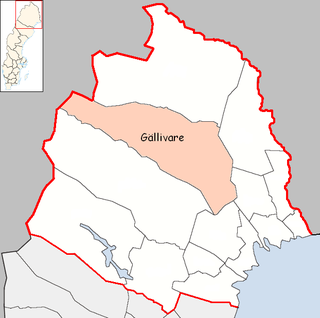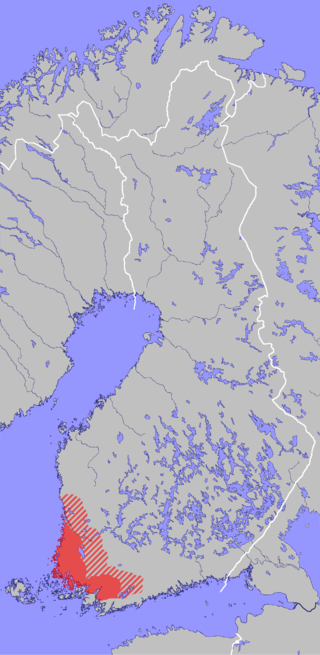In grammar, the inessive case is a locative grammatical case. This case carries the basic meaning of "in": for example, "in the house" is talo·ssa in Finnish, maja·s in Estonian, куд·са in Moksha, etxea·n in Basque, nam·e in Lithuanian, sāt·ā in Latgalian and ház·ban in Hungarian.
Colloquial or spoken Finnish is the unstandardized spoken variety of the Finnish language, in contrast with the standardized form of the language. It is used primarily in personal communication and varies somewhat between the different dialects.

Kankaanpää is a town and municipality of Finland. Kankaanpää was founded in 1865, became a township in 1967 and finally a town in 1972. It is located in the crossroads of Hämeenkangas and Pohjankangas ridges. It belongs to the region of Satakunta. Kankaanpää has a population of about 12,400 inhabitants, which make it the third largest municipality in the Satakunta region in terms of population, after the city of Pori and the town of Rauma. Pori is located 53 kilometres (33 mi) southwest of Kankaanpää.

South Ostrobothnia is one of the 19 regions of Finland. It borders the regions of Ostrobothnia, Central Ostrobothnia, Central Finland, Pirkanmaa, and Satakunta. Among the Finnish regions, South Ostrobothnia is the ninth largest in terms of population. Seinäjoki is the regional centre and by far the largest city in the area.

Ranua is a municipality of Finland. It is located in the province of Lapland. The municipality has a population of 3,599 and covers an area of 3,694.79 square kilometres (1,426.57 sq mi) of which 241.09 km2 (93.09 sq mi) is water. The population density is 1.04 inhabitants per square kilometre (2.7/sq mi).

Merikarvia is a municipality in Finland. It is located in the Satakunta region. The neighboring municipalities are Isojoki, Kristinestad, Pomarkku, Pori and Siikainen.
The exessive case is a grammatical case that denotes a transition away from a state. It is a rare case found in certain dialects of Baltic-Finnic languages. It completes the series of "to/in/from a state" series consisting of the translative case, the essive case and the exessive case.
Ostrobothnian Swedish is a variety of Finland-Swedish, spoken in Finland. Outside the autonomous island province of Åland, which is officially monolingually Swedish, Ostrobothnia is the only region of mainland Finland where Swedish-speakers are the majority (51%).

Rauma dialect is a Southwestern dialect of Finnish spoken in the town of Rauma, Finland.

Finnish is a Uralic language of the Finnic branch, spoken by the majority of the population in Finland and by ethnic Finns outside of Finland. Finnish is one of the two official languages of Finland. In Sweden, both Finnish and Meänkieli are official minority languages. The Kven language, which like Meänkieli is mutually intelligible with Finnish, is spoken in the Norwegian county Troms og Finnmark by a minority group of Finnish descent.

Gällivare dialects, alternately Gällivare Finnish or, in more colloquial Swedish, village Finnish, are a dialect group of Meänkieli or Northern Finnish. They are spoken around Gällivare, but also in Killivaara and Nattavaara.

Itä-Häme is the eastern part of the historical province Tavastia in Finland. It is in Päijänne Tavastia, Southern Savonia and Central Finland.

Finns proper are a historic people and a modern subgroup (heimo) of the Finnish people. They live in the areas of the historical province of Finland Proper and Satakunta, and they speak Southwestern dialects of Finnish. The Finns proper have had strong connections to Scandinavia throughout their history.
Ostrobothnians are a subgroup (heimo) of the Finnish people who live in the areas of the historical province of Ostrobothnia in the northwestern parts of Finland.

South Ostrobothnian dialect is a Western Finnish dialect. It is traditionally spoken in the region of South Ostrobothnia and parts of Coastal Ostrobothnia. The South Ostrobothnian dialect has many features that are unique to the region of South Ostrobothnia.

Central and Northern Ostrobothnian dialects are Western Finnish dialects spoken in Northern and Central Ostrobothnia, as well as in the Ranua municipality in Lapland. The dialects have been influenced by the Savonian dialects, the influence is weaker at the coasts and stronger in the inland areas.

South Karelian dialects, Karelian dialects or Southeast Finnish dialects are Eastern Finnish dialects spoken in South Karelia, along with eastern parts of Kymenlaakso. Prior to the Winter War, the dialects were spoken along the Karelian Isthmus and Ingria. However, the South Karelian dialect speakers from the parts of Karelia taken by the Soviet Union were evacuated into the rest of Finland where their speech was assimilated into the new environment. Use of the Ingrian dialects is declining.

Tavastian dialects are Western Finnish dialects spoken in parts of Western and Southern Finland. The dialect spoken in the city of Tampere is part of the Tavastian dialects. The Tavastian dialects have influenced other Finnish dialects.

Kainuu dialect is a dialect of Finnish spoken in Kainuu, Vaala, Koillismaa, Posio and Ranua. It belongs to the Savonian dialects, or more broadly, the eastern dialects of Finnish. Due to the region's close ties to North Ostrobothnia, the dialect has been influenced in vocabulary by Central and Northern Ostrobothnian dialects and vice versa.

Pohjaslahti is a village and former municipality of Finland at the time of its existence in the Häme Province, now in the Pirkanmaa region. It was divided between Vilppula and Virrat in 1973. Pohjaslahti was the last rural municipality to be created in Finland, which happened in 1941.
















